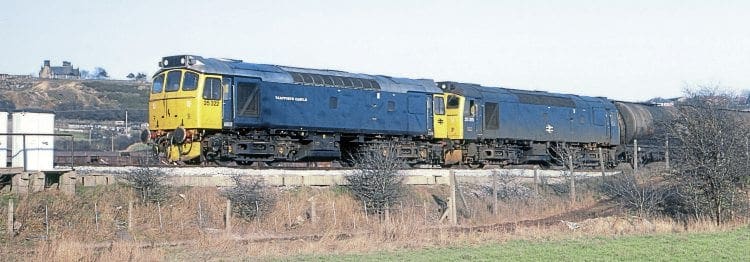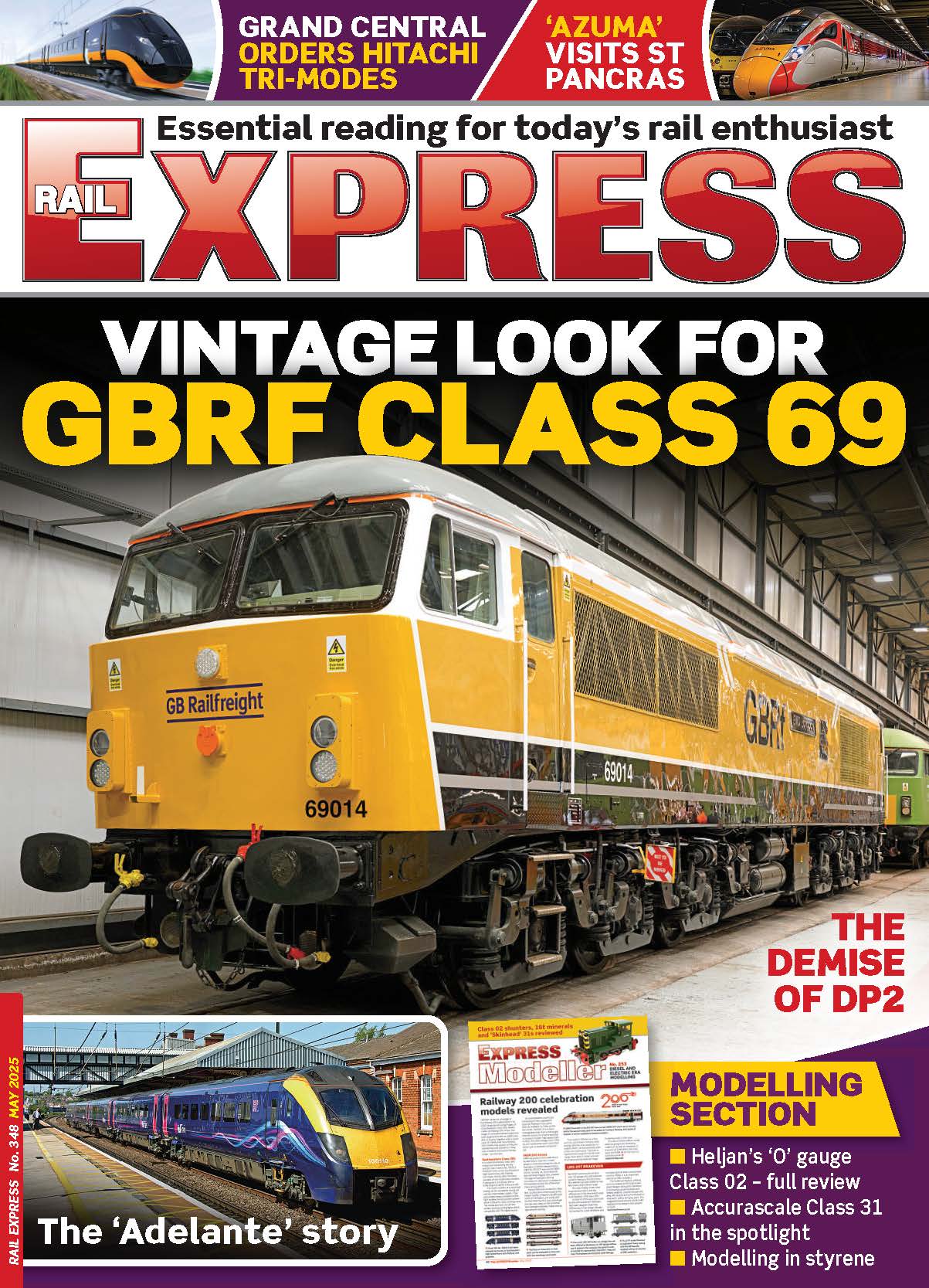FROM OUR ARCHIVES
March 30 (2016) marks the 25th anniversary of the withdrawal of celebrity Class 25 Tamworth Castle, which was resurrected long after the fleet had been withdrawn, and against the odds returned to the main line. David Russell tells the remarkable story.
THE 1980s saw the withdrawal of a large number of locos and the elimination of several types – including the Class 25s, which were progressively withdrawn up to 1987. The last 19 examples, which included six members of the Class 25/9 sub-class, were all switched off in March that year.

The Class 25/9 fleet, which had comprised 12 locos, was created in 1985 primarily for use on mineral trains operating in the North West. The locos chosen were all from the Class 25/3 sub-class with low engine hours and, to prolong their life, they were restricted to 60 mph.
Enjoy more Rail Express Magazine reading every month.
Click here to subscribe & save.
Among the locos picked for renumbering was No. 25322, which had already taken its first step towards celebrity. This Sulzer Type 2 had originally been withdrawn in January 1984, but was repainted by apprentices at Tyseley depot and unofficially named Tamworth Castle for display on
May 12-20 that year as part of a Tamworth Rail Week event. It also gained a new colour scheme – BR blue with full yellow cabs, black window frames, red buffer beams, and a grey roof.
After its display at Tamworth, the loco was reinstated to traffic at Bescot and became affectionately known as the ‘Ice Cream Van’ on account of its garish (for the time) colour scheme, which certainly made it stand out among the other Class 25s, many of which were in faded condition.
Sidelined at Crewe
Upon renumbering in November 1985, No. 25322 – which was by now based at Carlisle Kingmoor – became No. 25912.
Although the Class 25/9 fleet was initially expected to stay in use for three years, withdrawals started in late 1986, and on March 23, 1987 the last two examples – Nos. 25904/912 – were condemned and moved to Crewe Basford Hall.
That March also saw all the other remaining Class 25s withdrawn from use, and by early April more than 20 members of the class could be found at Basford Hall awaiting disposal, including the majority of those which had been taken out of traffic the previous month.
While most of the Class 25s at Basford Hall were to languish there for several months prior to being despatched to Vic Berry’s Leicester yard for asbestos removal (if sold for preservation) or scrap, a different fate was to befall No. 25912.
A requirement for a training loco on the Eastern Region saw the ‘Rat’ depart for Holbeck on April 15, arriving at its new Leeds base on May 6.
As the loco was not intended to operate on the main line, it was allocated a departmental identity –
No. ADB968027 – although this number was never carried.
Back from the dead
At Holbeck, apprentice training was carried out by undertaking various exams on the loco.
It soon became evident that the loco was in good enough condition to return it to main line use and, with a number of withdrawn Class 25s dumped at various sites around the country, procurement of spares was not a problem.
In addition, the loco was to receive bodywork attention and a repaint, emerging in two-tone green livery for the first time with its former identity of No. D7672 on April 24, 1989.
Cast Tamworth Castle nameplates were unveiled by Ian Foot, training engineer for the Eastern Region – the plates being provided by John Nuttall, area maintenance engineer at Holbeck. Working headcode blinds were refitted, along with ‘55A’ shedplates, this being the code for Holbeck from 1957 to 1973.
In order to put the ‘25’ back out on the main line, it needed the assistance of senior management. Fortunately, the Eastern Region’s CM&EE Alan Goldfinch backed the plan, and BR freight engineer David Russell (not the author of this article) also gave his support.
Mainline return
The first opportunity for the loco to stretch its legs occurred in early 1990 when, after the earlier success of a series of trains run over Leeds to Carlisle line using Classes 56 and 20 in November 1989, the loco was requested to pilot a train from Leeds to Carlisle and back.
On February 19, 1990 – almost three years since any ‘25’ had last worked on the main line – the loco undertook a successful test run from Neville Hill to Skipton and back with four coaches, during which there was concern about the amount of smoke in the engine room. Fortunately, it transpired that, as the exhaust system had not reached such a high temperature since withdrawal, grease and oil had become ingrained in the lagging, and so was not a major problem.
Five days later, the loco was at the head of the 1M09/08.25 Leeds-Carlisle, piloting No. 47422. The pair returned with the 1E11/12.42 Carlisle-Leeds. Hundreds of people turned out to see or travel on the trains.
Although these two trips were the only service trains to be operated by No. D7672 following its reactivation, over the next year or so, the loco was used on a number of charter trains. These included a trip from Appleby to Leeds that was arranged at short notice as some recompense for the non-appearance of Black 5 No. 44871 Sovereign, which had been booked to haul the train north earlier in the day.
The ‘25’ also put in appearances at various open days and events. At Doncaster Works open day in May 1990, a brass plaque was fitted, recording the names of those involved in the project to return the loco to service, namely Paul Corrie, Ken Tonks, Stephen Batty and Ian Parrish (who has since sadly passed away).
In all, Tamworth Castle was used on passenger workings seven times (see table). On each occasion, minor alterations were made to the loco’s embellishments, with the buffers and snowploughs receiving changes to their paintwork. On most trips, the loco was accompanied by traction inspector Bob Fitzakerly.
Final run
March 1991 was to prove to be the Class 25’s final month as a training loco at Holbeck. The loco effectively became a victim of sectorisation, as funding its continued operation was not a high priority for any of the newly created sectors.
A farewell trip, organised by Hertfordshire Rail Tours, took place on March 30. This was a bold move taking the loco from Leeds to Holyhead and back – its longest passenger outing since its return the previous year, and a real test with 10 coaches over the Pennines. But the loco was in tip-top condition, and it ran without a hitch.
Thereafter, the loco was put up for sale and bought by the North Staffordshire Diesel Group. It was despatched, under its own power, to MC Metals at Glasgow for asbestos removal on April 29, then moved to its new home at the Churnet Valley Railway the following month.
No. D7672 saw active use until 2001, when it was taken out of service pending overhaul and put into store, initially at Oakamoor. It was restored cosmetically in 2008 for a photo charter, re-gaining its ‘Ice Cream Van’ colours, which it operated in between 1984 and 1987 with the identity
No. 25322.
The loco’s present status is not so bright, however, as it is still in store at Cheddleton, awaiting restoration. But at least it has cheated the scrapman yet again, and hopefully there will be another comeback for the celebrity Type 2.
■ Special thanks are due to Ian Foot for his assistance in the preparation of this feature.




